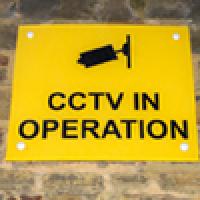
Terror networks
Terrorist networks have been the subject of mathematical modelling for some time, even though the field is fraught with difficulties. Recent work arising from a collaboration between Southern New Hampshire University, Intel Corporation, Keene State College and Computer Futures, Inc. has revealed several relevant characteristics of terrorist groups that need to be included in any mathematical model of a terrorist network, and has taken large steps towards more robust terrorist group modelling.

CCTV is widely used in the UK as a deterrent to terrorism.
In Disrupting Terrorist Networks - A Dynamic Fitness Landscape Approach, Philip V. Fellman, Jonathan P. Clemens, Roxana Wright, Jonathan Vos Post and Matthew Dadmun describe how even though terrorist networks remain shrouded in obscurity, there have been fruitful scientific approaches to their study, mainly in the area of network analysis.
Terrorist networks have a number of relevant characteristics which must be included in any mathematical model:
- They are covert. This means they have hidden properties meaning that any information included in a model about them will be incomplete. This increases the complexity of the task and the tools needed to determine the properties of the network structure;
- At the operational level, terrorist networks are purposive, which means that they have a definite purpose and therefore have formal characteristics such as recruitment constraints and ideological histories;
- Members of a terrorist network are often separated by large distances — this can arise from their covert nature. This structure can, in some circumstances, be mapped as a distributed network with an emergent shape. Network analysis models can be used to find key nodes and vertices within the distributed network which can be attacked. This can disrupt the organisation's ability to transmit commands across hierarchical levels and can lead to command degeneration.
- The difficulty with this approach is that terrorist networks are learning organisations with a far more loose hierarchy than, say, the military.
- Terrorist networks also have layers of redundant command meaning that disrupting one node of the network may not impact the organisation's ability to meet its ends.
The authors suggest that this all adds up to terrorist groups being "slippery foes" whose membership changes quickly and invisibly, and that they learn from their mistakes — that is, they evolve. Modelling evolution involves models of complexity and the authors combined a 1999 model of business decision-making with a famous theoretical model of evolution.
The 1999 model was developed by Pankaj Ghemawat of Harvard Business School and Daniel Levinthal of the Wharton School, who sort to define the properties of an optimal business organisation decision-making process by running an agent based simulation of decision-making. Agent based simulations are systems of interacting intelligent agents and are often used to solve problems which are difficult to solve analytically or with an individual agent. The work looked at how interdependent decision-making and the interdependence of business units affected the overall performance of a company.
The evolutionary model used was developed by well-regarded American theoretical biologist and complex systems researcher Stuart Kauffman. Kauffman's work concerned the origins of life on Earth and he is best known for arguing that the complexity of biological systems and organisms might result from self-organisation and non-equilibrium dynamics as opposed to (or in conjunction with) Darwinian natural selection. He also proposed the first models of Boolean networks.
Kauffman's NK-Boolean fitness model was used within the decision-making framework set up by Ghemawat and Levinthal to suggest some ways in which optimal decision-making for terrorist networks might be constrained and how the forced compartmentation of terrorist organisations by counter-terrorist security teams might impact the quality of terrorist decision-making and command execution.
Their conclusion is that, because terrorist networks have redundant decision structures, disruptions to the decision structure are often compensated for:
"The implicit lesson for intelligence organisations is that in dealing with terrorist organisations, efforts would best be directed at hitting them hard, at the highest levels of the hierarchy and leave the cleanup to local law enforcement organisations."
To read more about how terrorist groups have used cryptography, see the Plus article Terrorists' code of honour. For an overview of network analysis, see the Plus article Networks: nasty and nice, and to read about how network analysis has been used to model other surprising areas including the Eurovision song contest and communities of rap singers, see the Plus articles United Kingdom - twelve points and Rap: rivalry and chivalry.